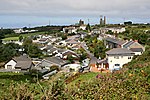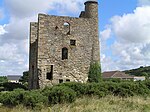King Edward Mine
Camborne School of MinesCopper mines in CornwallEducation in CornwallIndustrial archaeological sites in CornwallMining museums in Cornwall ... and 3 more
Museums in CornwallTin mines in CornwallUse British English from February 2023

The King Edward Mine at Camborne, Cornwall, in the United Kingdom is a mine wholly owned by Cornwall Council. At the end of the 19th century students at the Camborne School of Mines spent much of their time doing practical mining and tin dressing work in the local tin mines. The industry was almost in terminal decline and the surviving mines were falling behind technically. This was hardly ideal from the instruction point of view. The only real solution was for Camborne School of Mines to have its own underground mine.
Excerpt from the Wikipedia article King Edward Mine (License: CC BY-SA 3.0, Authors, Images).King Edward Mine
Grenville Gardens,
Geographical coordinates (GPS) Address Nearby Places Show on map
Geographical coordinates (GPS)
| Latitude | Longitude |
|---|---|
| N 50.204 ° | E -5.271 ° |
Address
Grenville United Mines
Grenville Gardens
TR14 9DU
England, United Kingdom
Open on Google Maps




